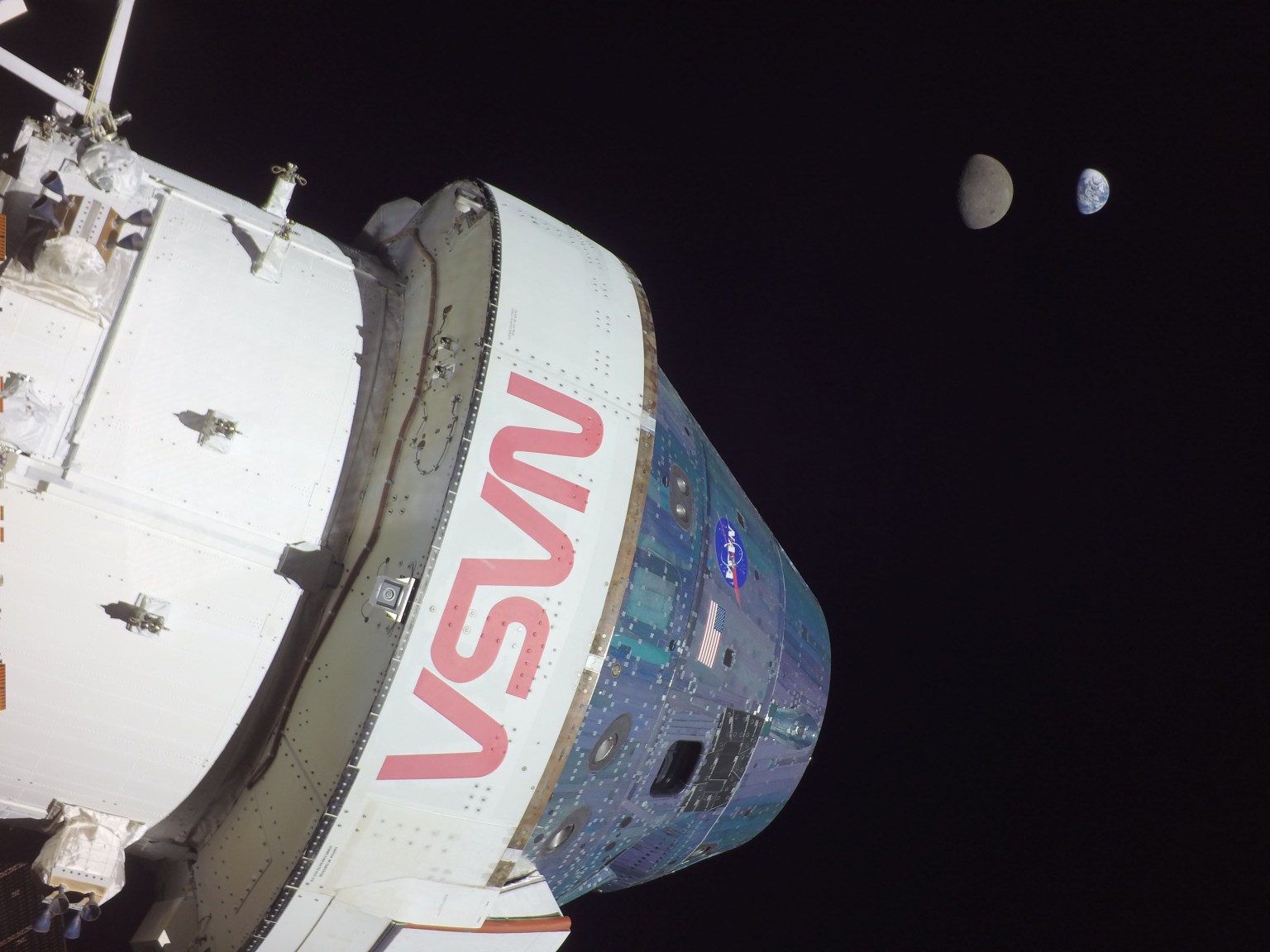Artemis in Motion Listening Sessions
Through Artemis in Motion Sessions, NASA Seeks Moon Storytelling Ideas As NASA pioneers new technologies and methods for storytelling in space for the benefit of humanity, the agency is hosting Artemis in Motion listening sessions with industry on Thursday, Jan. 23, and Friday, Jan. 24, in Los Angeles. From the live TV images of humanity’s […]
Artemis in Motion Listening Sessions

Through Artemis in Motion Sessions, NASA Seeks Moon Storytelling Ideas
As NASA pioneers new technologies and methods for storytelling in space for the benefit of humanity, the agency is hosting Artemis in Motion listening sessions with industry on Thursday, Jan. 23, and Friday, Jan. 24, in Los Angeles.
From the live TV images of humanity’s first steps on the Moon in July of 1969 to the July 2024 two-way 4k transmissions between the International Space Station and an airborne platform, NASA and its partners work on the frontiers of the media landscape to share historic achievements in space exploration.
As part of its Artemis campaign, NASA will land the next American astronauts and first international astronaut on the Moon, explore more of the Moon than ever before, and more.
Through NASA’s listening sessions, invited participants will learn about the agency’s work to tell the Artemis Generation’s lunar exploration story, and discuss new opportunities to highlight the agency’s work.
Today’s advances in technology, storytelling, and production make it possible to share the experience of landing, living, and working on the Moon in ways never before possible. NASA wants to hear how participants would share the extraordinary story of sustained human presence and exploration throughout the solar system, which is rooted across three balanced pillars of science, inspiration, and national posture.
NASA’s OTPS (Office of Technology, Policy, and Strategy), Office of Communications, and the Exploration System Mission Directorate are organizing the sessions in coordination with Science Mission Directorate, and the Space Operations Mission Directorate.
Overview
With the Artemis campaign, NASA is returning to the Moon to discover the unknown, advance technology, and to learn how to live and work on another world as we prepare for human missions to Mars.
Artemis I successfully completed an uncrewed mission in 2022, and in 2026 Artemis II will next send four crew members to fly around the Moon. As early as mid-2027, Artemis III and subsequent missions will once again bring humans back to the surface of the Moon, landing for the first time where no people have been before: the lunar South Pole region. Like the historic Apollo landings 50 years ago, these missions to the surface of the Moon will provide unparalleled opportunities for motion imagery to inspire and ignite the imagination of people around the world.
NASA and its commercial partners will have integrated cameras on human landing systems and spacesuits, as well as each astronaut carrying their own handheld camera. But we know the modern age offers many creative ways to share these moments, ways to let each of us “ride along” with the crew. NASA is calling on media producers and distributors, studios, imagery companies, space companies, academia, and other interested parties to share their ideas directly with NASA leadership.
Each participant will be asked to make a 30-minute presentation to be delivered in a one-on-one session to the NASA team. Concepts should focus on the Artemis III-V missions (for more on each Artemis missions see NASA’s Moon to Mars Architecture), particularly the time they will spend on the lunar surface. NASA has particular interest in information that informs three key questions:
- What could supplement NASA’s planned acquisition, communication, distribution, etc. of lunar imagery? (See the FAQ section for an overview of our current plans.)
- What could be done with the video, photography, and telemetry from the mission(s) to creatively share the return of humans to the Moon in unique and compelling ways?
- How could NASA collaborate with your organization to help NASA tell the story of Artemis in a unique way?
There are no associated activities (e.g., procurement, cooperative agreement, Space Act agreement, etc.) planned at this time.
Session Details
Beyond the in-person events already planned and depending on demand, NASA may offer additional virtual sessions the week of February 3rd. The agency also is engaging the entertainment community through a private panel presentation at the Motion Picture Academy.
If space allows, participants will be invited to attend an information session on the Artemis campaign and its motion imagery opportunities the morning of Jan. 23. We will provide more information on the optional briefing upon RSVP.
Organizations interested in booking a listening session should email their request to: hq-dl-artemis-in-motion@mail.nasa.gov with the following information by Monday, Jan. 13:
- Organization name
- Participant name(s) – limit to three
- Point of contact email and phone number
- Request for in-person or virtual session
NASA will set the session schedule and contact organizations directly to confirm all details. No slide decks or digital presentations are permitted during the sessions, although you may bring printed materials.
Please do not share confidential or proprietary information during the sessions. We will not record the sessions, however, NASA staff may take notes.
For more information on the Artemis in Motion listening sessions, please read our FAQ section below. You may send additional questions or requests for guidance on your presentation to hq-dl-artemis-in-motion@mail.nasa.gov. Please note we may add your questions to the FAQ below if deemed helpful to other participants.
Artemis in Motion Listening Sessions FAQ
Q: Does NASA have any specific opportunities it is seeking ideas for?
A: NASA is looking to explore the art of the possible in ideas that supplement, improve, or expand the use of imagery from the lunar surface, and will accept any information on ideas that forward the story of Artemis and that adheres with NASA’s principles. The following list of potential opportunities are examples of what may interest the listening team. These are examples only and not meant to restrict the scope of presentations.
A deployable or separately landed camera system for third-person point-of-view imagery from the lunar surface.
- A deployable or separately landed camera system for third-person point-of-view imagery from the lunar surface.
- Non-traditional imagery options including virtual reality, augmented reality, and similar immersive technologies.
- Collaboration with the NASA+ team to stream a live event to a very large audience.
- A TV series or production leading up to and around the Artemis missions.
- An efficient, space-rated encoder to transmit live, high-quality video from the HULC (Handheld Universal Lunar Camera), a ruggedized version of the Nikon Z9.
- Processing techniques to increase data throughput or recall for ground operations.
- An approach to increasing the bandwidth available to downlink more or higher quality videos.
Q: What sources of imagery does NASA already plan to have on the lunar surface?
A: NASA expects to have access to at least three sources of imagery on the lunar surface:
- External and internal video cameras mounted on the Human Landing System.
- A video camera mounted on each astronaut suit, providing the perspective of the crew members during EVA.
- The HULC (a modified Nikon Z 9) that will be carried by each crew member to provide real-time photography.
These sources will offer a variety of perspectives, including live video up to UHD resolution. Video will be standard 16:9 format; there are no current plans for stereoscopic video, 360-degree cameras, or spatial video/audio.
NASA currently plans to stream live content via its NASA+ platform as an over-the-top service, as well as provide a backhaul feed to the media. It will also archive and release the photography and video, including any imagery returned from the Moon later with the crew.
Q: How would additional imagery be routed on the Moon and back to Earth?
A: NASA imagery will be routed through the Human Landing System and then downlinked to Earth via the Deep Space Network (DSN). Equipment on the surface of the Moon will transmit imagery to the Human Landing System via Wi-Fi; Artemis III may also include a development test objective for a 4G/LTE connection. We expect limited data bandwidth for any non-critical video links, ranging from single-digit to low double-digit megabits per second. It could be possible for solutions to support increased bandwidth by supporting downlink direct to Earth or through a lunar relay system.
Q: What is the weight limit for new systems brought to the Moon?
A: While there isn’t a specific weight limit, additional imagery systems ideally are low in mass, size, weight, power, and bandwidth due to the limited capacity for the early Artemis missions.
Q: Can an organization propose a production or solution for which they would have exclusive rights?
A: NASA has previously entered into content agreements with organizations that involve some level of exclusivity. However, NASA seeks to benefit all humanity and especially desires solutions that can be shared with the widest possible audience.
Q: Can an organization propose a production that involves content before and after the mission such as content with crew members?
A: Yes. NASA expects the story of a mission to not just include the time on the Moon, but the launch and splashdown; the story of the Artemis campaign to not just include the mission itself but the engineering, the training, the uncrewed test flights, and their impact.
Q: Are listening sessions open to organizations outside the United States?
A: Yes, participation by international entities is encouraged. International space agencies interested in discussing opportunities are encouraged to reach out directly to hq-dl-artemis-in-motion@mail.nasa.gov.
Q: Can NASA help certify or design the hardware for use on the Lunar Surface?
A: Any hardware would need to meet the NASA interface and safety requirements to fly. The specifics of those interfaces, as well as the possibility of NASA support in meeting them, would be discussed in any follow-on discussions or solicitations. (As a reminder, NASA is also interested in concepts that do not require providing and flying new hardware.)
Q: Must any solution be completely autonomously operated or could it link to a suit or the Human Landing System for data and power and/or be operated by a crew member?
A: A solution could provide its own communication system or it could route data transmission to and through the Human Landing System, which could be done via Wi-Fi (Artemis III may also include a development test objective for a 4G/LTE connection). Routing data through or getting power from the suit is likely to not be a feasible option. Crew may be able to set up a camera on the lunar surface, but crew time is too constrained to expect the crew to continue to operate the camera. Human Landing System support for providing power for or exchanging commands with a payload would need to be evaluated on a case-by-case basis.
Q: Will information from the presentations be shared?
A: NASA does not intend to share information from the individual sessions outside of the agency.
Share
Details
Related Terms
What's Your Reaction?



















.jpg?#)
































